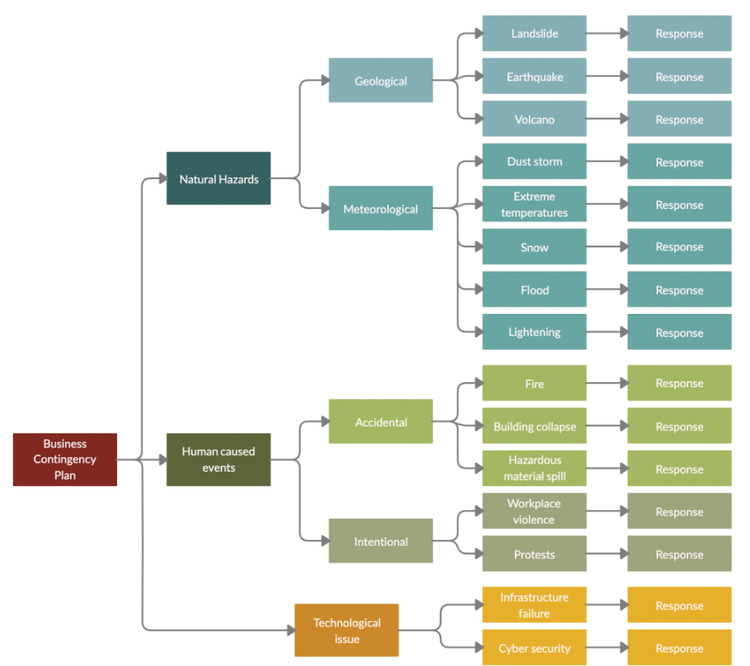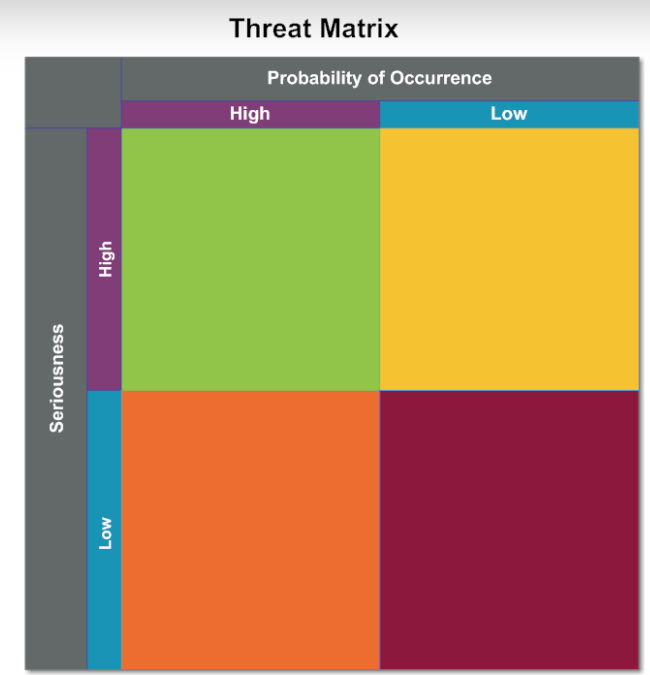Plan A in the business world is essentially the same for every company on any given day: Keep doing what works well to increase revenue and customer satisfaction.
Unexpected business disruptions such as natural disasters, technology failures, and even the COVID-19 pandemic, however, are inevitable. That’s why a business contingency plan -- your Plan B -- is essential to minimize the impact of these events on day-to-day operations.
Overview: What is a contingency plan?
A business contingency plan identifies a variety of catastrophic events that could occur and formulates responses to mitigate their effects.
These situations, as with the examples above, are typically beyond your control, so the best you can do is determine your optimal course of action when time is of the essence to protect your business.
The business contingency plan is much like project risk management but on a larger scale. Instead of anticipating and managing risk at the team or department level, the business contingency plan is applicable across large swaths, if not all, of your company.
What to consider when developing a contingency plan
Input from all levels within your organization, everyone from senior-level executives to front-line workers, is critical when developing a business contingency plan as part of your change management efforts.
In addition, because extreme events are inevitable without being predictable, how quickly you recover from these situations will be one of your key business metrics.
You also need to keep the three considerations below in mind to shape an effective business contingency plan.
1. Financial solvency
When a crisis happens, the number one priority is the continued operation of the company, which ultimately boils down to cash flow and solvency. This requires thinking proactively about your cash reserves, liquid assets, and bottom-line numbers to keep the lights on and doors open.
2. Customer loyalty
After making sure your company can survive the financial impact of a catastrophic event, the next issue is customer loyalty. While everyone knows the unexpected can and will happen, your customers demand that you respond quickly and transparently.
Anything less than that can lead to a damaged reputation and customer defection to your competitors.
3. Negative and positive events
Being ready to deal with negative events like a natural disaster is a common contingency plan example, but you also need to be prepared when unexpected good fortune comes your way.
If a marketing initiative goes viral and leads to a spike in orders, which could strain your supply chain and production capabilities, you must have a plan for that too.
How to write a contingency plan
As part of your business development efforts, contingency planning is also a form of gap analysis. You will not only be identifying potential threats and their relative likelihood, but you’ll also be determining how prepared you are now versus where you need to be to ensure operations continue with the minimum amount of interruption.
Step 1: List potential threats
The first step in compiling the information necessary to flesh out a contingency plan template is to identify all the potential threats your company faces. In general, these can be broken out into three categories: natural disasters, human-caused events, and technology failures.
Tips for listing potential threats:
To determine the maximum number of potential threats, you’ll need to cast a wide net by soliciting input from multiple departments and personnel within your organization as well as other stakeholders. In addition, business consultants, who have a perspective beyond that of the company itself, can offer valuable insights.
- Collect quantitative and qualitative information: Surveys will generate quantitative information such as statistics about perceived potential threats, while one-on-one interviews employing open-ended questions will provide more subjective, qualitative information.
- Use a visual threat chart: Organizing potential threats visually by way of diagrams or mind maps will also aid the subsequent contingency planning steps beyond the use of text or lists alone.

A visual threat chart will help categorize the different types of crises that could impact business operations. Image source: Author
Step 2: Prioritize potential threats
Once you’ve identified all potential threats, everything from a power outage to the eruption of a volcano to a cyberattack, you’ll need to prioritize each threat based on its general likelihood. After all, if you’re located on a coastline, flooding will be more likely than the dust storm that might be a routine occurrence in an arid region.
Tips for prioritizing potential threats:
You’ll want to use a uniform "instrument" -- that is, a consistent method -- to analyze the potential impact of different disasters based on the information you collected in step one. Otherwise, you could end up with an ever-moving target that will make your resource allocation less effective.
- Calculate risk in multiple areas: “Risk” is a broad term, so when it comes to calculating the relative threat from different events, break the impact out into categories including physical resources, human resources, company reputation, and legal/regulatory liabilities.
- Use a threat matrix: Much like a prioritization matrix, a threat matrix will help you visualize which potential events deserve more attention by calculating whether the threat’s impact is high or low and if it is more or less likely to occur.

A threat matrix allows you to plot multiple threats to determine which ones warrant higher priority. Image source: Author
Step 3: Formulate threat responses
Now you are ready to lay out your responses to various threats. Critical elements to determine your standard operating procedure for each scenario include personnel responsibilities, equipment, cost, offsite contacts and service providers, and recovery timeline.
Tips for formulating threat responses:
Your threat responses must be detailed enough to provide clear guidance during a crisis. At the same time, they cannot be so granular that they don’t allow the flexibility necessary to respond quickly as chaotic events unfold.
- Test each response plan: Most contingency plans fail due to inadequate testing. Just as you need fire drills so everyone knows how to get out of a building, each plan needs regularly scheduled dry runs to time how long it takes, identify any weaknesses, and revise as necessary.
- Identify proactive measures: After determining what needs to be done to resume operations after an unexpected event, work backward to see what you can do before it occurs. If you’re worried about losing power, for example, consider adding backup generators or using a more robust data backup protocol to prevent unnecessary losses.
Step 4: Communicate the contingency plan
Once each contingency plan has been tested and approved, it must be easily available to all employees and stakeholders. After all, it won’t do any good gathering dust in a three-ring binder on the top shelf in a locked storeroom.
Tips for communicating the contingency plan:
As with other planning documents, including financial, strategic, and succession, your contingency plans are living documents, not museum pieces, and must be treated as such.
- Perform regular reviews: By scheduling periodic reviews on at least an annual basis, employee knowledge of procedures will be reinforced. In addition, they can provide input for ongoing updates.
- Use online/mobile applications: In addition to having hard copy plans, make this information available online and through mobile applications. That way, people can respond appropriately even if they are offsite or are at a remote business location.
Common pitfalls to avoid when creating a contingency plan
Successful contingency planning deals with the same issues as all other project planning: avoiding silos, updating results, and disseminating information.
1. Lack of input
Contingency planning cannot be left to one department or, even more problematically, to one person due to the scope of processes, money, and personnel involved in recovery efforts.
You should use a cross-functional team to obtain actionable input from a variety of organizational perspectives.
2. Lack of current information
In addition, your contingency management plan is not a static document because it presents your best options and responses at a single point in time.
As your business evolves, personnel change and different resources and capabilities become available, you’ll need to regularly revisit the contingency planning process to reflect these changes.
3. Lack of communication
The best contingency planning in the world won’t do you any good if nobody knows about this key piece of business intelligence or how to access it in the middle of an emergency.
Make sure everyone knows how to find this information, their respective roles to play, and how to reach and remain in contact with other members of your disaster response teams.
Start on your business contingency plan today
Strictly speaking, developing your business contingency strategy is not a front-line, day-to-day operations activity. At the same time, a lack of planning for the worst things that could happen threatens the very existence of your company.
That’s why you need to maximize your efforts and be as efficient as possible by using, for example, the best project management software to work both smart and hard.
Our Small Business Expert
We're firm believers in the Golden Rule, which is why editorial opinions are ours alone and have not been previously reviewed, approved, or endorsed by included advertisers. The Ascent does not cover all offers on the market. Editorial content from The Ascent is separate from The Motley Fool editorial content and is created by a different analyst team.